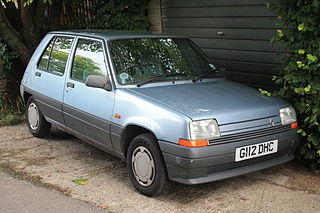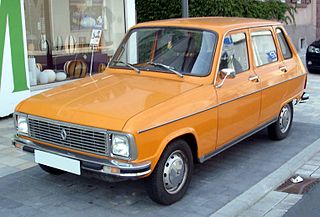
A hatchback is a car body configuration with a rear door that swings upward to provide access to the main interior of the car as a cargo area rather than just to a separated trunk. Hatchbacks may feature fold-down second-row seating, where the interior can be reconfigured to prioritize passenger or cargo volume.

The Vauxhall Chevette is a supermini car that was manufactured by Vauxhall in the United Kingdom from 1975 to 1984. It was Vauxhall's version of the "T-Car" small-car family from Vauxhall's parent General Motors (GM), and based primarily on the Opel Kadett C. The family also included the Isuzu Gemini in Japan, the Holden Gemini in Australia, the Chevrolet Chevette in the United States, Canada, Brazil, Colombia, Ecuador and Argentina, and in the U.S. and Canada it was also rebadged as the Pontiac Acadian/Pontiac T1000.

The Opel Kadett is a small family car produced by the German automobile manufacturer Opel from 1936 until 1940 and then from 1962 until 1991, when it was succeeded by the Opel Astra.

The Ford Orion is a small family car that was produced by Ford Europe from 1983 until 1993. A total of 3,534,239 units were sold during the car's ten-year production life.

The Renault 5 is a five-passenger, three or five-door, front-engine, front-wheel drive hatchback supermini manufactured and marketed by the French automaker Renault over two generations: 1972–1985 and 1984–1996. The R5 was marketed in the US and Canada as Le Car, from 1976 until 1983. Renault marketed a four-door sedan variant, the Renault 7, manufactured from 1974 until 1984 in Spain by Renault's subsidiary FASA-Renault and exported to select markets.

The Renault 9 and Renault 11 are small family cars produced by the French manufacturer Renault from 1981–1988 in saloon and hatchback configurations — both were styled by the French automobile designer, Robert Opron.

The Peugeot 104 is a supermini car produced by the French company Peugeot between 1972 and 1988. It was designed by Paolo Martin was initially only sold as a four-door saloon car, with a three-door hatchback variant introduced in 1974 and a five-door hatchback version replacing the saloon in 1976. The 104 was the first model produced at the company's Mulhouse plant. It was also the first new Peugeot introduced since 1955 not to be offered in a diesel version.

The Simca 1307 is a large family car produced by Chrysler Europe and subsequently PSA Peugeot Citroën from 1975 to 1986. Codenamed 'C6' in development, the car was styled in the United Kingdom by Roy Axe and his team at Whitley, and the car was engineered by Simca at Poissy in France.

The Renault 16 (R16) is a D-segment family hatchback produced by French automaker Renault between 1965 and 1980 in Le Havre, France. The Renault 16 was the first French winner of the European Car of the Year award.

The Renault 5 Turbo or R5 Turbo is a sport hatchback automobile launched by the French manufacturer Renault at the Brussels Motor Show in January 1980. The car was primarily designed for rallying, but was also sold in a street version.

The Simca 1100 are a series of French compact family cars – mainly C-segment hatchbacks, but also a compact wagon and popular delivery vans – built for over 15 years by French car-maker Simca, from 1967 through 1982/1985. There was even a very early 'hot hatchback', and a family cross-over: the Matra Simca Rancho. The hatchbacks were replaced by the Simca-Talbot Horizon.

The Ford Escort is a small family car that was manufactured by Ford of Europe from 1968 until 2000. In total there were six generations, spread across three basic platforms: the original, rear-wheel-drive Mk.1/Mk.2 (1968–1980), the "Erika" front-wheel-drive Mk.3/Mk.4 (1980–1992), and the final CE-14 Mk.5/Mk.6 (1990–2002) version. Its successor, the Ford Focus, was released in 1998, but the final generation of Escort was phased out gradually, with the panel van version ending production in 2002 in favour of the Ford Transit Connect.

The Renault 6 or R6 is an economy C-segment small family car, manufactured and marketed by French automaker Renault from 1968 to 1986. The R6 entirely used the Renault 4's platform, initially including its small 845 cc (51.6 cu in) engine, and was technically near-identical, but its five-door hatchback body was larger and more modern. Visually it resembled the larger Renault 16, but distincly boxier.

The Renault 18 is a large family car produced by French manufacturer Renault between 1978 and 1989, with South American production continuing until 1994. It formed the basis for the closely related Renault Fuego Coupé, with which it shared its floorpan and drivetrain, but with the Fuego initially using the negative offset type front suspension from the larger Renault 20/30, which became standardized across the 18 range from the 1983 model year onwards.

The Datsun Cherry (チェリー), known later as the Nissan Cherry, was a series of subcompact cars which formed Nissan's first front-wheel drive supermini model line.

The Cléon-Fonte engine is a family of inline four-cylinder automobile engines developed and manufactured by Renault. It has also been called the Sierra engine, the C-engine, or the C-Type. It has been in continuous production by Renault or a licensee from 1962 to 2004. After about three decades of use in Renault's compact models, it was gradually replaced by the E-type engine from the late 1980s onward.
1983 in motoring deals with developments in the automotive industry throughout 1983 by various automobile manufacturers, grouped by country. The automotive industry designs, develops, manufactures, markets, and sells motor vehicles, and is one of the Earth's most important economic sectors by revenue.
1989 in motoring includes developments in the automotive industry throughout the year 1989 by various automobile manufacturers, grouped by country. The automotive industry designs, develops, manufactures, markets, and sells motor vehicles.
1979 in motoring deals with developments in the automotive industry that occurred in 1979, listed by country. The automotive industry designs, develops, manufactures, markets, and sells motor vehicles.
France was a pioneer in the automotive industry and is the 11th-largest automobile manufacturer in the world by 2015 unit production and the third-largest in Europe. It had consistently been the 4th-largest from the end of World War II up to 2000. It is 16% of sales of French manufactured products.




















